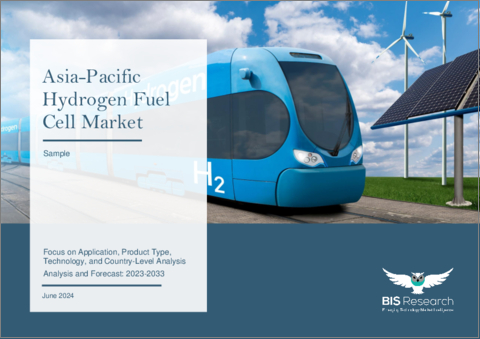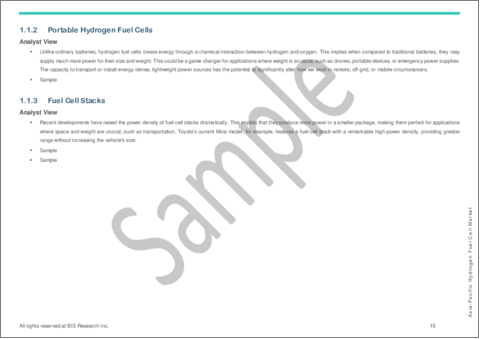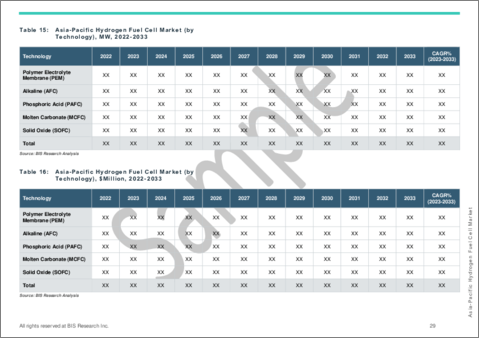|
|
市場調査レポート
商品コード
1503255
アジア太平洋の水素燃料電池市場:用途別、製品タイプ別、技術別、国別分析:分析と予測(2023年~2033年)Asia-Pacific Hydrogen Fuel Cell Market: Focus on Application, Product Type, Technology, and Country-Level Analysis - Analysis and Forecast, 2023-2033 |
||||||
カスタマイズ可能
|
|||||||
| アジア太平洋の水素燃料電池市場:用途別、製品タイプ別、技術別、国別分析:分析と予測(2023年~2033年) |
|
出版日: 2024年07月01日
発行: BIS Research
ページ情報: 英文 85 Pages
納期: 1~5営業日
|
全表示
- 概要
- 図表
- 目次
アジア太平洋の水素燃料電池の市場規模は、2023年に16億7,210万米ドルとなりました。
同市場は、2023年から2033年にかけて20.97%のCAGRで拡大し、2033年には112億2,570万米ドルに達すると予測されています。水素燃料電池は主に、従来の燃焼ベースのエネルギー源に代わるよりクリーンな代替手段を提供する、環境の持続可能性と効率性で評価されています。
| 主要市場統計 | |
|---|---|
| 予測期間 | 2023年~2033年 |
| 2023年評価 | 16億7,210万米ドル |
| 2033年予測 | 112億2,570万米ドル |
| CAGR | 20.97% |
アジア太平洋の水素燃料電池市場は、クリーンエネルギー技術への投資の増加と二酸化炭素排出量削減への取り組みにより、大幅な成長が見込まれています。日本、韓国、中国などの国々が、自動車、定置用発電、携帯用電子機器など様々な分野での水素燃料電池の採用をリードしています。これらの燃料電池は、ゼロ・エミッション、高いエネルギー効率、静かな運転といった利点を備えており、持続可能なエネルギーソリューションを必要とする用途にとって魅力的です。政府のイニシアティブ、水素インフラ開発へのインセンティブ、官民のパートナーシップが、APAC全域での市場拡大を加速しています。課題としては、インフラ投資の必要性、水素製造の拡張性、従来技術とのコスト競争力などが挙げられます。しかし、技術の継続的な進歩と支援政策により、アジア太平洋の水素燃料電池市場は、低炭素経済への移行において極めて重要な役割を果たすと期待されています。
当レポートでは、アジア太平洋の水素燃料電池市場について調査し、市場の概要とともに、用途別、製品タイプ別、技術別、国別の動向、および市場に参入する企業のプロファイルなどを提供しています。
目次
エグゼクティブサマリー
第1章 市場
- 動向:現在および将来の影響評価
- サプライチェーンの概要
- エコシステムと進行中のプログラム
- 研究開発レビュー
- 規制状況
- ステークホルダー分析
- 主要な世界的出来事の影響分析-COVID-19
- 市場力学:概要
第2章 地域
- 地域別概要
- 促進要因と抑制要因
- アジア太平洋
第3章 市場-競合ベンチマーキングと企業プロファイル
- 今後の見通し
- 地理的評価
- Panasonic
- TW Horizon Fuel Cell Technologies
- Toshiba America Energy Systems Corporation (TAES)
- Mitsubishi Hitachi Power Systems
- Shanghai Pearl Hydrogen Energy Technology Co.
- Doosan Fuel Cell Co., Ltd.
- KYOCERA Corporation
第4章 調査手法
List of Figures
- Figure 1: Asia-Pacific Hydrogen Fuel Cell Market (by Scenario), $Billion, 2022, 2026, and 2033
- Figure 2: Hydrogen Fuel Cell Market (by Region), $Million, 2022, 2026, 2033
- Figure 3: Hydrogen Fuel Cell Market, Pricing Analysis (by Region), $/Watt, 2022, 2026, and 2033
- Figure 4: Asia-Pacific Hydrogen Fuel Cell Market (by Application), $Million, 2022, 2026, 2033
- Figure 5: Asia-Pacific Hydrogen Fuel Cell Market (by Product Type), $Million, 2022, 2026, 2033
- Figure 6: Asia-Pacific Hydrogen Fuel cell Market (by Technology), $Million, 2022, 2026, 2033
- Figure 7: Key Events
- Figure 8: Supply Chain and Risks within the Supply Chain
- Figure 9: Value Chain Analysis
- Figure 10: Patent Analysis (by Number of Patents), January 2020-December 2023
- Figure 11: Patent Analysis (by Country), January 2020-December 2023
- Figure 12: Impact Analysis of Market Navigating Factors, 2023-2033
- Figure 13: China Hydrogen Fuel Cell Market, $Million, 2022-2033
- Figure 14: India Hydrogen Fuel Cell Market, $Million, 2022-2033
- Figure 15: Japan Hydrogen Fuel Cell Market, $Million, 2022-2033
- Figure 16: South Korea Hydrogen Fuel Cell Market, $Million, 2022-2033
- Figure 17: Rest-of-Asia-Pacific Hydrogen Fuel Cell Market, $Million, 2022-2033
- Figure 18: Strategic Initiatives (by Company), 2020-2023
- Figure 19: Share of Strategic Initiatives, January 2020-December 2023
- Figure 20: Data Triangulation
- Figure 21: Top-Down and Bottom-Up Approach
- Figure 22: Assumptions and Limitations
List of Tables
- Table 1: Market Snapshot
- Table 2: Opportunities across Regions
- Table 3: Heavy-Duty Fuel Cell Truck Models
- Table 4: Competitive Landscape Snapshot
- Table 5: Trends Overview
- Table 6: Hydrogen Fuel Cell Market Pricing Forecast (by Region), $/Watt, 2022-2033
- Table 7: Regulatory Bodies
- Table 8: Characteristics of Nikola FCEV Truck
- Table 9: Hydrogen Fuel Cell Market (by Region), MW, 2022-2033
- Table 10: Hydrogen Fuel Cell Market (by Region), $Million, 2022-2033
- Table 11: Asia-Pacific Hydrogen Fuel Cell Market (by Application), MW, 2022-2033
- Table 12: Asia-Pacific Hydrogen Fuel Cell Market (by Application), $Million, 2022-2033
- Table 13: Asia-Pacific Hydrogen Fuel Cell Market (by Product Type), MW, 2022-2033
- Table 14: Asia-Pacific Hydrogen Fuel Cell Market (by Product Type), $Million, 2022-2033
- Table 15: Asia-Pacific Hydrogen Fuel Cell Market (by Technology), MW, 2022-2033
- Table 16: Asia-Pacific Hydrogen Fuel Cell Market (by Technology), $Million, 2022-2033
- Table 17: China Hydrogen Fuel Cell Market (by Application), MW, 2022-2033
- Table 18: China Hydrogen Fuel Cell Market (by Application), $Million, 2022-2033
- Table 19: China Hydrogen Fuel Cell Market (by Product Type), MW, 2022-2033
- Table 20: China Hydrogen Fuel Cell Market (by Product Type), $Million, 2022-2033
- Table 21: China Hydrogen Fuel Cell Market (by Technology), MW, 2022-2033
- Table 22: China Hydrogen Fuel Cell Market (by Technology), $Million, 2022-2033
- Table 23: India Hydrogen Fuel Cell Market (by Application), MW, 2022-2033
- Table 24: India Hydrogen Fuel Cell Market (by Application), $Million, 2022-2033
- Table 25: India Hydrogen Fuel Cell Market (by Product Type), MW, 2022-2033
- Table 26: India Hydrogen Fuel Cell Market (by Product Type), $Million, 2022-2033
- Table 27: India Hydrogen Fuel Cell Market (by Technology), MW, 2022-2033
- Table 28: India Hydrogen Fuel Cell Market (by Technology), $Million, 2022-2033
- Table 29: Japan Hydrogen Fuel Cell Market (by Application), MW, 2022-2033
- Table 30: Japan Hydrogen Fuel Cell Market (by Application), $Million, 2022-2033
- Table 31: Japan Hydrogen Fuel Cell Market (by Product Type), MW, 2022-2033
- Table 32: Japan Hydrogen Fuel Cell Market (by Product Type), $Million, 2022-2033
- Table 33: Japan Hydrogen Fuel Cell Market (by Technology), MW, 2022-2033
- Table 34: Japan Hydrogen Fuel Cell Market (by Technology), $Million, 2022-2033
- Table 35: South Korea Hydrogen Fuel Cell Market (by Application), MW, 2022-2033
- Table 36: South Korea Hydrogen Fuel Cell Market (by Application), $Million, 2022-2033
- Table 37: South Korea Hydrogen Fuel Cell Market (by Product Type), MW, 2022-2033
- Table 38: South Korea Hydrogen Fuel Cell Market (by Product Type), $Million, 2022-2033
- Table 39: South Korea Hydrogen Fuel Cell Market (by Technology), MW, 2022-2033
- Table 40: South Korea Hydrogen Fuel Cell Market (by Technology), $Million, 2022-2033
- Table 41: Rest-of-Asia-Pacific Hydrogen Fuel Cell Market (by Application), MW, 2022-2033
- Table 42: Rest-of-Asia-Pacific Hydrogen Fuel Cell Market (by Application), $Million, 2022-2033
- Table 43: Rest-of-Asia-Pacific Hydrogen Fuel Cell Market (by Product Type), MW, 2022-2033
- Table 44: Rest-of-Asia-Pacific Hydrogen Fuel Cell Market (by Product Type), $Million, 2022-2033
- Table 45: Rest-of-Asia-Pacific Hydrogen Fuel Cell Market (by Technology), MW, 2022-2033
- Table 46: Rest-of-Asia-Pacific Hydrogen Fuel Cell Market (by Technology), $Million, 2022-2033
- Table 47: Market Share
Introduction to Asia-Pacific Hydrogen Fuel Cell Market
The Asia-Pacific hydrogen fuel cell market was valued at $1,672.1 million in 2023 and is expected to reach $11,225.7 million by 2033, with a CAGR of 20.97% from 2023 to 2033. Hydrogen fuel cells are valued primarily for their environmental sustainability and efficiency, offering a cleaner alternative to traditional combustion-based energy sources.
| KEY MARKET STATISTICS | |
|---|---|
| Forecast Period | 2023 - 2033 |
| 2023 Evaluation | $1,672.1 Million |
| 2033 Forecast | $11,225.7 Million |
| CAGR | 20.97% |
Market Introduction
The Asia-Pacific (APAC) hydrogen fuel cell market is poised for substantial growth driven by increasing investments in clean energy technologies and efforts to reduce carbon emissions. Countries like Japan, South Korea, and China are leading the adoption of hydrogen fuel cells in various sectors including automotive, stationary power generation, and portable electronics. These fuel cells offer advantages such as zero emissions, high energy efficiency, and quiet operation, making them attractive for applications requiring sustainable energy solutions. Government initiatives, incentives for hydrogen infrastructure development, and partnerships between public and private sectors are accelerating market expansion across APAC. Challenges include the need for infrastructure investment, hydrogen production scalability, and cost competitiveness compared to conventional technologies. Nonetheless, with ongoing advancements in technology and supportive policies, the APAC hydrogen fuel cell market is expected to play a pivotal role in the region's transition towards a low-carbon economy.
Market Segmentation:
Segmentation 1: by Application
- Stationary Power
- Portable Power
- Transport
- Passenger Cars
- Commercial Vehicles
- Others
Segmentation 2: by Product Type
- Liquid-Cooled Type
- Air-Cooled Type
Segmentation 3: by Technology
- Polymer Electrolyte Membrane (PEM)
- Alkaline (AFC)
- Phosphoric Acid (PAFC)
- Molten Carbonate (MCFC)
- Solid Oxide (SOFC)
Segmentation 4: by Region
- Japan
- India
- China
- South Korea
- Rest-of-Asia-Pacific
How can this report add value to an organization?
Product/Innovation Strategy: The product segment helps the reader understand the different product types and technologies available for deployment and their potential. Moreover, the study provides the reader with a detailed understanding of the hydrogen fuel cell market by application on the basis of application (stationary power, portable power, transport) and product on the basis of product type (liquid-cooled type, air-cooled type), by technology (polymer electrolyte membrane (PEM), alkaline (AFC), phosphoric acid (PAFC), molten carbonate (MCFC), solid oxide (SOFC)).
Growth/Marketing Strategy: The hydrogen fuel cell market has seen major development by key players operating in the market, such as business expansion, partnership, collaboration, and joint venture. The favored strategy for the companies has been merger and acquisition to strengthen their position in the hydrogen fuel cell market.
Competitive Strategy: Key players in the Asia-Pacific hydrogen fuel cell market analyzed and profiled in the study involve major hydrogen fuel cell offering companies for various applications. Moreover, a detailed competitive benchmarking of the players operating in the hydrogen fuel cell market has been done to help the reader understand how players stack against each other, presenting a clear market landscape. Additionally, comprehensive competitive strategies such as partnerships, agreements, and collaborations will aid the reader in understanding the untapped revenue pockets in the market.
Key Market Players and Competition Synopsis
The companies that are profiled in the report have been selected based on thorough secondary research, which includes analyzing company coverage, product portfolio, market penetration, and insights gathered from primary experts.
Some prominent names established in the market are:
- Panasonic
- TW Horizon Fuel Cell Technologies
- Toshiba America Energy Systems Corporation (TAES)
- Mitsubishi Hitachi Power Systems
- Shanghai Pearl Hydrogen Energy Technology Co.
- Doosan Fuel Cell Co., Ltd.
- KYOCERA Corporation
Table of Contents
Executive Summary
Scope and Definition
1 Markets
- 1.1 Trends: Current and Future Impact Assessment
- 1.1.1 Trends: Overview
- 1.1.2 Portable Hydrogen Fuel Cells
- 1.1.3 Fuel Cell Stacks
- 1.2 Supply Chain Overview
- 1.2.1 Value Chain Analysis
- 1.2.2 Market Map
- 1.2.3 Pricing Forecast
- 1.3 Ecosystem and Ongoing Programs
- 1.3.1 Consortiums and Associations
- 1.3.1.1 H-Mat: Hydrogen Materials Consortium
- 1.3.1.2 HydroGEN
- 1.3.1.3 ElectroCat (Electrocatalysis) Consortium
- 1.3.2 Regulatory Bodies
- 1.3.3 Government Programs
- 1.3.3.1 India's National Green Hydrogen Mission
- 1.3.3.2 China's Hydrogen Industry Development Plan (2021-2035)
- 1.3.1 Consortiums and Associations
- 1.4 Research and Development Review
- 1.4.1 Patent Filing Trend (by Number of Patents, Country)
- 1.5 Regulatory Landscape
- 1.6 Stakeholder Analysis
- 1.6.1 Use Case: Case Study: Nikola Hydrogen Fuel Cell Electric Vehicle
- 1.6.2 End Users and Buying Criteria
- 1.7 Impact Analysis for Key Global Events - COVID-19
- 1.8 Market Dynamics: Overview
- 1.8.1 Market Drivers
- 1.8.1.1 Decarbonization Targets and Environmental Regulations
- 1.8.1.2 Technological Advancements and Cost Reductions
- 1.8.1.3 Potential for Integration with Other Renewable Technologies
- 1.8.2 Market Restraints
- 1.8.2.1 High Initial Investment Costs
- 1.8.2.2 Market Penetration in Emerging Markets
- 1.8.2.3 Cost Competitiveness with Conventional Fuels
- 1.8.3 Market Opportunities
- 1.8.3.1 Integration Services for Renewable Energy Systems
- 1.8.3.2 Hydrogen Refueling Infrastructure for Urban Centers
- 1.8.1 Market Drivers
2 Regions
- 2.1 Regional Summary
- 2.2 Drivers and Restraints
- 2.3 Asia-Pacific
- 2.3.1 Regional Overview
- 2.3.2 Driving Factors for Market Growth
- 2.3.3 Factors Challenging the Market
- 2.3.4 Application
- 2.3.5 Product
- 2.3.6 Asia-Pacific (by Country)
- 2.3.6.1 China
- 2.3.6.2 India
- 2.3.6.3 Japan
- 2.3.6.4 South Korea
- 2.3.6.5 Rest-of-Asia-Pacific
3 Markets - Competitive Benchmarking & Company Profiles
- 3.1 Next Frontiers
- 3.2 Geographic Assessment
- 3.2.1 Panasonic
- 3.2.1.1 Overview
- 3.2.1.2 Top Products/Product Portfolio
- 3.2.1.3 Top Competitors
- 3.2.1.4 Target Customers
- 3.2.1.5 Key Personnel
- 3.2.1.6 Analyst View
- 3.2.1.7 Market Share, 2022
- 3.2.2 TW Horizon Fuel Cell Technologies
- 3.2.2.1 Overview
- 3.2.2.2 Top Products/Product Portfolio
- 3.2.2.3 Top Competitors
- 3.2.2.4 Target Customers
- 3.2.2.5 Key Personnel
- 3.2.2.6 Analyst View
- 3.2.2.7 Market Share, 2022
- 3.2.3 Toshiba America Energy Systems Corporation (TAES)
- 3.2.3.1 Overview
- 3.2.3.2 Top Products/Product Portfolio
- 3.2.3.3 Top Competitors
- 3.2.3.4 Target Customers
- 3.2.3.5 Key Personnel
- 3.2.3.6 Analyst View
- 3.2.3.7 Market Share, 2022
- 3.2.4 Mitsubishi Hitachi Power Systems
- 3.2.4.1 Overview
- 3.2.4.2 Top Products/Product Portfolio
- 3.2.4.3 Top Competitors
- 3.2.4.4 Target Customers
- 3.2.4.5 Key Personnel
- 3.2.4.6 Analyst View
- 3.2.4.7 Market Share, 2022
- 3.2.5 Shanghai Pearl Hydrogen Energy Technology Co.
- 3.2.5.1 Overview
- 3.2.5.2 Top Products/Product Portfolio
- 3.2.5.3 Top Competitors
- 3.2.5.4 Target Customers
- 3.2.5.5 Key Personnel
- 3.2.5.6 Analyst View
- 3.2.5.7 Market Share, 2022
- 3.2.6 Doosan Fuel Cell Co., Ltd.
- 3.2.6.1 Overview
- 3.2.6.2 Top Products/Product Portfolio
- 3.2.6.3 Top Competitors
- 3.2.6.4 Target Customers
- 3.2.6.5 Key Personnel
- 3.2.6.6 Analyst View
- 3.2.6.7 Market Share, 2022
- 3.2.7 KYOCERA Corporation
- 3.2.7.1 Overview
- 3.2.7.2 Top Products/Product Portfolio
- 3.2.7.3 Top Competitors
- 3.2.7.4 Target Customers
- 3.2.7.5 Key Personnel
- 3.2.7.6 Analyst View
- 3.2.7.7 Market Share, 2022
- 3.2.1 Panasonic
4 Research Methodology
- 4.1 Data Sources
- 4.1.1 Primary Data Sources
- 4.1.2 Secondary Data Sources
- 4.1.3 Data Triangulation
- 4.2 Market Estimation and Forecast





